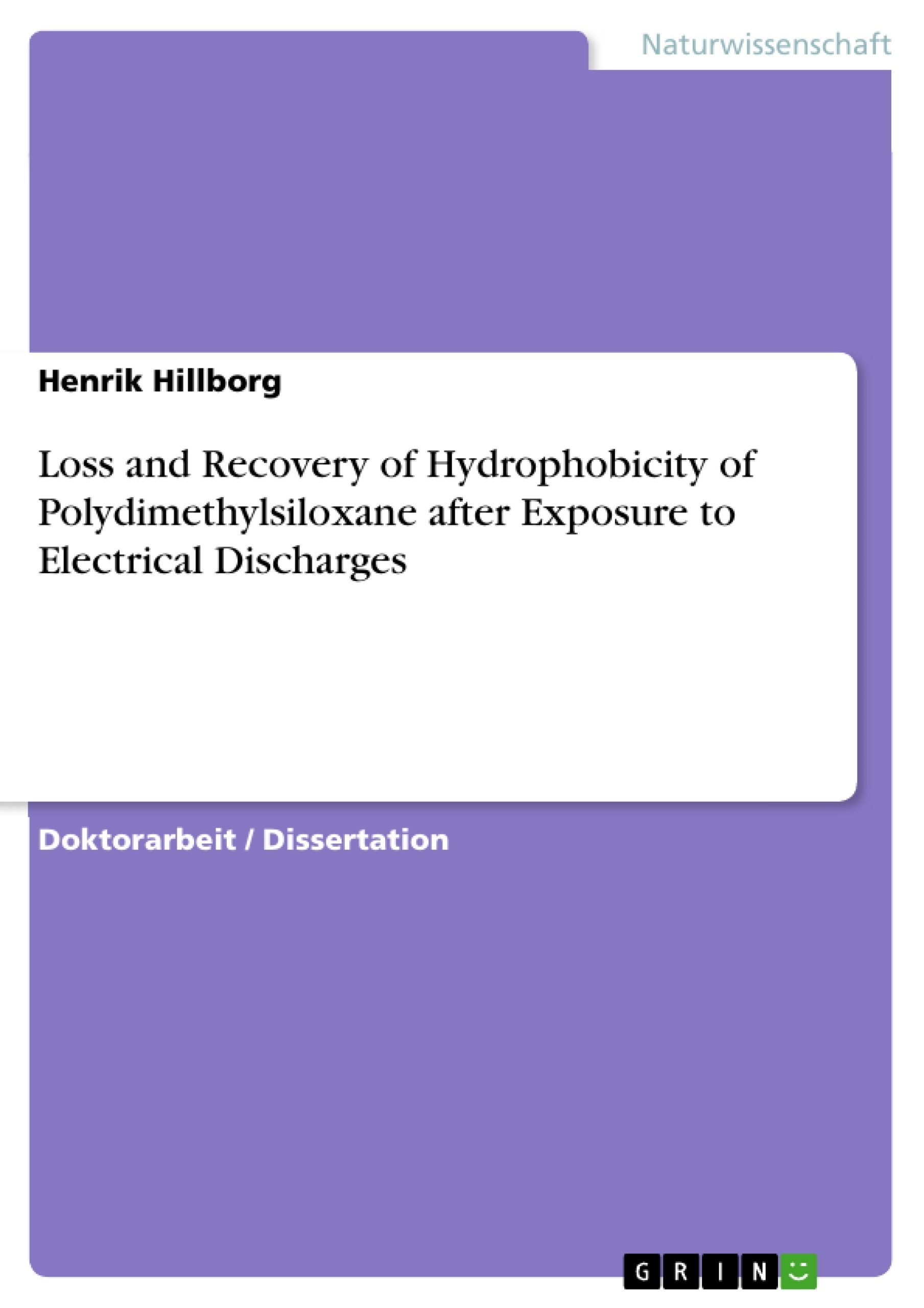Silicone rubber based on polydimethylsiloxane is used as high voltage outdoor insulation, due to its ability to preserve the hydrophobic surface properties during service, and even regain hydrophobicity after exposure to electrical discharges. The underlying processes for the hydrophobic recovery are diffusion of low molar mass siloxanes from the bulk to the surface and reorientation by conformational changes of molecules in the surface region. Only little is known of which factors are responsible for the long-term stability of this hydrophobic recovery. It is therefore important to increase the knowledge about the fundamental mechanisms for the loss and recovery of hydrophobicity of silicone rubbers, exposed to electrical discharges. Addition-cured polydimethylsiloxane networks, with known crosslink densities, were exposed to corona discharges and air/oxygen-plasma and the loss and recovery of hydrophobicity was characterised by contact angle measurements. The degree of surface oxidation increased with increasing exposure time with a limiting depth of 100- 150 nm, as assessed by neutron reflectivity measurements. The oxidation rate increased with increasing crosslink density of the polymer network, according to X-ray photoelectron spectroscopy. Within the oxidised layer, a brittle, silica-like top-layer was gradually developed with increasing exposure time. The hydrophobic recovery following the corona or air/oxygen- plasma exposures occurred at a slow pace by diffusion of cyclic oligomeric dimethylsiloxanes through the micro-porous but uncracked silica-like surface layer, or at a much higher pace by transport of the oligomers through cracks in the silica-like layer. The oligomers were present in the bulk, but additional amounts were formed during exposure to corona discharges. In addition high-temperature vulcanised silicone rubber specimens were aged in a coastal environment under high electrical stress levels (100 V/mm). The changes in surface structure and properties were compared to the data obtained from specimens exposed to corona discharges/plasma. The dominating degradation mechanism was thermal depolymerisation, initiated by hot discharges. This resulted in the formation of mobile siloxanes, of which the low molar mass fraction consisted of cyclic oligomeric dimethylsiloxanes. Oxidative crosslinking resulting in silica-like surface layers was not observed during these conditions.
Inhaltsverzeichnis
- 1. INTRODUCTION
- 1.1 Purpose of this study
- 1.2 The author's contribution
- 2. BACKGROUND
- 2.1 Properties of polydimethylsiloxane
- 2.1.1 General description
- 2.1.2 Production of the polymer
- 2.1.3 Production of a crosslinked network
- 2.1.4 Rubber formulations for high voltage outdoor insulation
- 2.2 Silicon rubber as outdoor high voltage insulation
- 2.2.1 General applications
- 2.2.2 Log-term performance
- 2.3 Loss and recovery of hydrophobicity-electrical discharges
- 2.3.1 Loss of hydrophobicity
- 2.3.2 Hydrophobic recovery
- 2.4 Thermal degradation of polydimethylsiloxane
- 2.5 Influence of environmental factors on hydrophobicity
- 2.5.1 Water immersion
- 2.5.2 UV radiation
- 3. EXPERIMENTAL
- 3.1 Materials
- 3.1.1 HTV silicone rubber (Paper I)
- 3.1.2 'Exact' PDMS networks (Papers II-IV, VI)
- 3.1.3 Field aged silicone rubber formulation (Paper VII)
- 3.2 Conditions during exposure to electrical discharges
- 3.2.1 Corona discharges
- 3.2.2 Radio-frequency plasma (RF)
- 3.2.3 Microwave plasma (MW)
- 3.3 Characterisation techniques
- 3.3.1 Contact angle measurements
- 3.3.2 Wilhelmy balance
- 3.3.3 Reflection infrared spectroscopy (IR)
- 3.3.4 X-ray photoelectron spectroscopy (XPS)
- 3.3.5 Scanning electron microscopy (SEM)
- 3.3.6 Atomic force microscopy (AFM)
Zielsetzung und Themenschwerpunkte
Diese Arbeit untersucht die Prozesse des Verlusts und der Wiederherstellung der Hydrophobizität von Polydimethylsiloxan (PDMS) nach Exposition gegenüber elektrischen Entladungen. Das Hauptziel ist es, die zugrundeliegenden Mechanismen besser zu verstehen und die Faktoren zu identifizieren, die die Langzeitstabilität dieser Hydrophobie-Wiederherstellung beeinflussen.
- Verlust der Hydrophobizität durch elektrische Entladungen
- Mechanismen der Hydrophobie-Wiederherstellung
- Einfluss der Vernetzungsdichte auf den Verlust und die Wiederherstellung der Hydrophobizität
- Charakterisierung der Oberflächenveränderungen mittels verschiedener Techniken
- Untersuchung der thermischen Degradation von PDMS
Zusammenfassung der Kapitel
Kapitel 1 (Einführung): Dieses Kapitel beschreibt die Zielsetzung und den Umfang der Studie. Kapitel 2 (Hintergrund): Dieser Abschnitt behandelt die Eigenschaften von Polydimethylsiloxan, dessen Verwendung als Hochspannungsisolation im Außenbereich und die bekannten Mechanismen von Hydrophobieverlust und -wiederherstellung. Kapitel 3 (Experimentell): Hier werden die verwendeten Materialien, die Bedingungen der Exposition gegenüber elektrischen Entladungen und die eingesetzten Charakterisierungstechniken detailliert beschrieben.
Schlüsselwörter
Polydimethylsiloxan, Hydrophobizität, elektrische Entladungen, Koronaentladungen, Plasma, Oberflächencharakterisierung, Degradation, Vernetzungsdichte, Silikonkautschuk.
- Quote paper
- Henrik Hillborg (Author), 2001, Loss and Recovery of Hydrophobicity of Polydimethylsiloxane after Exposure to Electrical Discharges, Munich, GRIN Verlag, https://www.grin.com/document/189395



